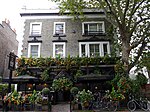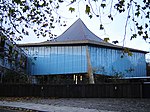Edwardes Square
1820 establishments in EnglandCommunal gardensGarden squares in LondonGrade II* listed parks and gardens in LondonGrade II listed houses in the Royal Borough of Kensington and Chelsea ... and 4 more
Houses completed in 1820KensingtonLondon geography stubsSquares in the Royal Borough of Kensington and Chelsea

Edwardes Square is a garden square in Kensington, London, W8. The square was built between 1811 and 1820. 1–23 and 25–48 Edwardes Square are listed Grade II for their architectural merit.
Excerpt from the Wikipedia article Edwardes Square (License: CC BY-SA 3.0, Authors, Images).Edwardes Square
Pembroke Gardens Close, London Earl's Court (Royal Borough of Kensington and Chelsea)
Geographical coordinates (GPS) Address Nearby Places Show on map
Geographical coordinates (GPS)
| Latitude | Longitude |
|---|---|
| N 51.497191 ° | E -0.200682 ° |
Address
Edwardes Square
Pembroke Gardens Close
W8 6HW London, Earl's Court (Royal Borough of Kensington and Chelsea)
England, United Kingdom
Open on Google Maps











